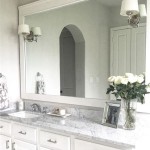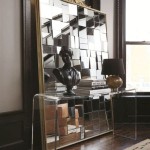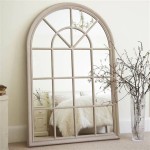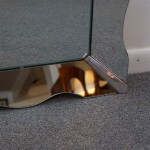White Distressed Mirrors: A Guide to Style, Selection, and Placement
White distressed mirrors offer a unique blend of vintage charm and contemporary style. Their versatility allows them to complement a variety of interior design aesthetics, from farmhouse rustic to shabby chic and even modern minimalist. This article explores the characteristics, benefits, and practical considerations involved in selecting and incorporating white distressed mirrors into various spaces.
The defining feature of a white distressed mirror is its finish. This "distressed" look is achieved through various techniques, including layering and sanding paint to reveal underlying coats, creating a weathered, timeworn appearance. The level of distressing can range from subtle hints of wear to more pronounced chipping and cracking, offering a spectrum of styles to suit individual preferences.
The white color itself provides a neutral backdrop that enhances the reflective qualities of the mirror. It brightens a room, creating an illusion of more space and light. This makes white distressed mirrors particularly suitable for smaller rooms or spaces with limited natural light. Moreover, the neutral white complements a wide range of color palettes and design elements, making it a versatile choice for diverse interiors.
Beyond their aesthetic appeal, white distressed mirrors offer several practical advantages. The distressed finish often camouflages minor imperfections or smudges, making them relatively low-maintenance compared to pristine, high-gloss mirrors. Furthermore, the textured surface of the distressed finish can add visual interest and depth to a wall, acting as a decorative element in its own right.
Several factors should be considered when selecting a white distressed mirror. Size is a primary consideration, as it dictates the mirror's impact and functionality. A large, oversized mirror can serve as a statement piece and significantly enhance the sense of space, while smaller mirrors can be grouped together for a decorative effect or used practically in bathrooms or hallways.
The frame material and style also play a significant role in the overall aesthetic. Common frame materials include wood, metal, and resin. Wooden frames offer a classic, rustic appeal, while metal frames can lend a more industrial or modern touch. Resin frames provide a lightweight and cost-effective option, often mimicking the look of carved wood.
The shape of the mirror is another important design element. Traditional rectangular and square shapes are versatile and easily incorporated into various settings. Round or oval mirrors can soften the lines of a room and add a touch of elegance. More unique shapes, such as arched or geometric designs, can serve as focal points and express individual style.
The degree of distressing is a matter of personal preference. Subtly distressed mirrors offer a refined, understated look, while heavily distressed mirrors convey a more rustic, antique feel. Examining the specific techniques used to achieve the distressed finish, such as layering, sanding, or antiquing, can help in choosing a mirror that aligns with the desired aesthetic.
Placement of a white distressed mirror significantly impacts its effect. In living rooms, a large mirror placed above a fireplace mantel or console table can create a focal point and reflect the room's décor. In dining rooms, a strategically placed mirror can amplify the light from a chandelier or create a sense of grandeur.
Bedrooms benefit from the reflective qualities of white distressed mirrors, making the space feel larger and brighter. A full-length mirror is practical for dressing, while a smaller, decorative mirror can be placed above a dresser or vanity. In bathrooms, white distressed mirrors complement various styles, from traditional to contemporary, adding both functionality and decorative appeal.
Hallways and entryways can also benefit from the addition of a white distressed mirror. A strategically placed mirror can brighten a narrow hallway and create a welcoming first impression in an entryway. The reflective surface can also enhance the sense of space in these often-confined areas.
When incorporating white distressed mirrors into a room, it's essential to consider the existing décor and color scheme. While white is a versatile color, the distressed finish adds a layer of texture and visual interest. Balancing this with other elements in the room is key to creating a cohesive and aesthetically pleasing space. Consider the surrounding furniture, wall colors, and other decorative accents to ensure the mirror complements rather than competes with the overall design.
White distressed mirrors offer a versatile and stylish way to enhance a variety of interior spaces. From adding light and depth to introducing a touch of vintage charm, their unique combination of functionality and aesthetic appeal makes them a valuable addition to any home. Careful consideration of size, shape, frame style, and distressing level, alongside thoughtful placement, will ensure that the chosen mirror seamlessly integrates into the desired aesthetic and enhances the overall design of the room.

Versailles Large White Wall Mirror Landscape And Portrait From The Lighthouse

White Rectangle Distressed Wood Frame Mirror Foreside Home Garden Target

Distressed White Reclaimed Wood Wall Mirror With Frame

Brandtworks American Value Distressed White Wall Mirror Com

Brandtworks Oversized Distressed White Farmhouse Mirror 71 In H X 21 5 W Bm32thin The Home Depot

How To Cheat A Distressed Look Confessions Of Serial Do It Yourselfer

Antiqued Elegance Wall Mirror Antique Farmhouse

Gallery Solutions 21x25 Distressed White Scoop Framed Beveled Wall Accent Mirror Com

Brandtworks Distressed 22 In W X 32 H Framed Rectangular Bathroom Vanity Mirror White Bm032s The Home Depot

Rustic French Bedroom Mirror Distressed White And Brown Solid Wood 1 Kroger








